The Blood Relics From the Lincoln Assassination
Even now, 150 years later, objects from the murder of the president provide a powerful link to the event
/https://tf-cmsv2-smithsonianmag-media.s3.amazonaws.com/filer/04/f8/04f87473-9755-43d4-a3d3-1c5b7d50941e/march-2015-booth-revolver4.jpg)
Every April 14, on the hour of the assassination of Abraham Lincoln, the place where it happened is one of the loneliest historical sites in America.
I should know. I’ve been making disappointing anniversary pilgrimages to the scene for more than a quarter of a century. My first was in 1987, during my first spring in Washington, D.C., when my future wife and I were serving in the Reagan administration. After work, we walked to the then-seedy neighborhood surrounding Ford’s Theatre and discovered Geraldine’s House of Beef, a restaurant whose only attraction was a table near the front window that offered a clear view of Ford’s facade on Tenth Street NW. We decided to have dinner while we waited to see what would happen. Of course, we thought, a crowd would arrive soon to honor the most beloved president in American history. No doubt the National Park Service, which has administered Ford’s since 1933, would hold a solemn ceremony.
Nine p.m., nothing. Ten p.m.—about 20 minutes before the moment John Wilkes Booth fired his single-shot Deringer pistol at the back of the president’s head and changed the nation’s destiny—nothing. Then we saw movement. A station wagon turned onto Tenth Street. In it was a picture-postcard American family—two parents and two young children, a boy and a girl. As the car slowed and coasted past, the driver pointed out the window to the theater. The kids’ heads swiveled to their left and nodded up and down. The car drove on.
That was it. That was how the American people honored Abraham Lincoln on the night and at the place of his assassination. I did not realize it then, but that was the moment that would lead me to write my book Manhunt: The 12-Day Chase for Lincoln’s Killer.
On all the April 14ths that followed, nothing changed at Ford’s. Far from inviting people to sit vigil, the National Park Service’s security guards and police discouraged nighttime anniversary visitors. In 2013, I almost got arrested trying to honor Lincoln.
Around 9 p.m. I sat, as had become my habit, on the front steps of the Petersen House, the boardinghouse where Lincoln died at 7:22 a.m. on April 15, 1865. It, too, is administered by the National Park Service as part of the assassination historical site. I imagined the theater doors across the way bursting open and the shouting, frenzied audience of 1,500 flooding Tenth Street. I could see in my mind’s eye the unconscious president as he was carried into the street. I pictured how a Petersen House resident opened the door at the top of the staircase and shouted, “Bring him in here!” and how the soldiers carried him past the very spot where I sat.
Across the street, a guard inside Ford’s Theatre pushed open a plexiglass door next to her security desk and bellowed: “Get off those steps! You can’t sit there. That’s private property. I’ll call the police.” I got up and crossed the street. I explained to her that tonight was the anniversary of Lincoln’s assassination. That I served on the advisory council of the Ford’s Theatre Society. That I had written a book about what had happened. And those steps, I couldn’t resist reminding her, belonged to the American people.
She gaped at me, uncomprehending. I returned to the Petersen House and sat down. Ten minutes later, two park service police cars pulled up. The three cops said that Officer Johnson had reported a hostile homeless man lurking about. “Lots of men sit on these steps and urinate on the house,” said one of the officers. “How do we know you’re not going to do that? You’ve got no right to sit here.” After much tense discussion, another officer rolled his eyes and advised me to enjoy the evening.
Last year, I brought two friends along as reinforcements. The country was in the middle of celebrating the 2011-15 Civil War sesquicentennial. Surely that would bring people out. But no. Fewer than ten people showed up. I posted a disappointed report on Twitter. And received no comments.
Things promise to be different this April 14, the 150th anniversary of the assassination. The Ford’s Theatre Society and the park service will transform Tenth Street into a time tunnel that will transport visitors back to the sights and sounds of 1865. Starting the morning of April 14, the street will be closed to traffic. Ford’s will stay open for 36 hours straight to accommodate a schedule of short history plays, readings, musical performances and moments of silence. Street vendors will hawk small paper flags celebrating the fall of Richmond and the effective end of the Civil War, just as they did in 1865, right up to the moment of the assassination.
And at 10:20 p.m., all will go silent, until a bugler playing taps breaks the spell. Then, for the first time in 150 years, mourners will hold a torchlight vigil in front of the Petersen House. I will be there too, marking the climax of a lifelong fascination with the assassination of Abraham Lincoln.
I was born on February 12, Lincoln’s birthday. From childhood, I received books and souvenirs about him as gifts. When I was 10, my grandmother presented me with an engraving of Booth’s Deringer. Framed with it was a clipping cut from the Chicago Tribune the day Lincoln died. But the story was incomplete, ending in mid-sentence. I hung it on my bedroom wall and reread it hundreds of times during my childhood, often thinking, “I want to know the rest of the story.” I still have it today.
On weekends I begged my parents to take me to the old Chicago Historical Society so I could visit its most prized relic, Lincoln’s deathbed. I longed to go to Washington to visit Ford’s Theatre, and my father took me with him on a business trip there. That boyhood curiosity turned me into an obsessive lifelong collector of original Lincoln assassination documents, photographs and artifacts.
And years later, it led to the books: Manhunt; its sequel, Bloody Crimes; and even a book for young adults, Chasing Lincoln’s Killer. I could not have written them without my personal archive. In fact, I think of myself as a crazed collector who happens to write books. My collection contains magical objects that resonate with meaning. They don’t just reflect history; they are history. For the 150th anniversary, I’ve picked out my favorite Lincoln assassination relics—from my collection and others—that best bring alive what Walt Whitman called that “moody, tearful night.”
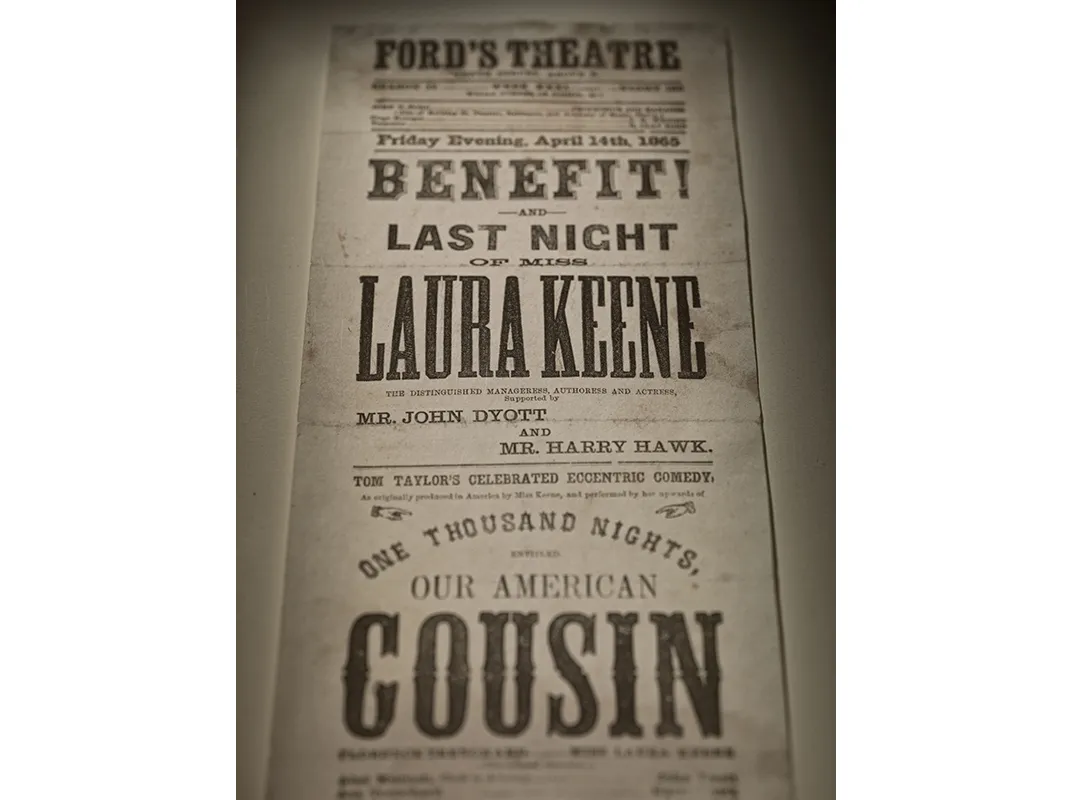
Ford’s Theatre Playbill
On the morning of Friday, April 14, 1865, Mary Lincoln notified Ford’s Theatre that she and the president would attend that night’s performance of Our American Cousin. That pleased Laura Keene. The show was a “benefit” for the star actress; she would share in the profits, which would presumably grow as word of the first couple’s plans spread. A few blocks away, on D Street near Seventh, H. Polkinhorn & Son printed a playbill—something to hand out on the street that day to drum up ticket sales. But that night’s events invested this common-place piece of theatrical ephemera with unparalleled significance: It freezes a snapshot of the “before.”
For me, the playbill conjures the opening scenes from one of Lincoln’s happiest nights: the presidential carriage arriving on Tenth Street, and inside the theater the sound of cheers, “Hail to the Chief,” laughter and hissing gaslights. It also resonates with eerie foreboding, symbolizing not only Lincoln’s death, but also the end of Ford’s Theatre, which would go dark for more than a century. Lincoln loved theater, and coming to Ford’s. Whenever I leave my house to go there, where I often attend performances and other events, I always glance at the playbill hanging in my hallway. It reminds me that Ford’s is not just a place of death. Lincoln laughed there, too.
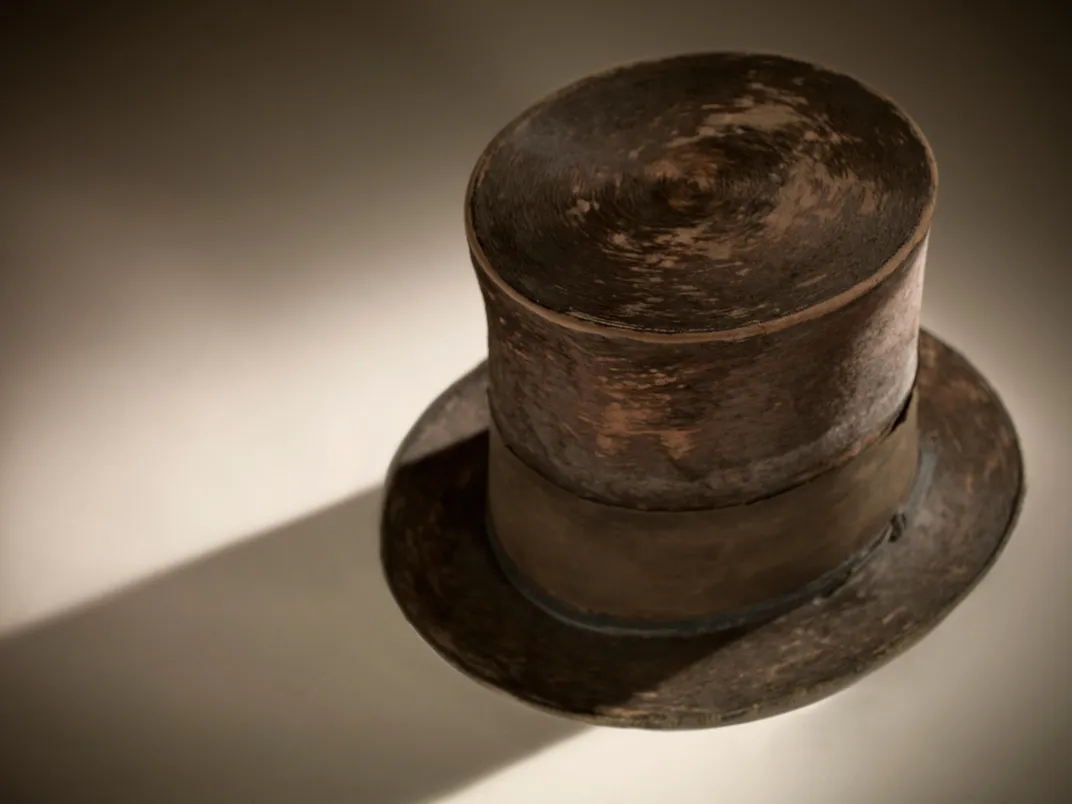
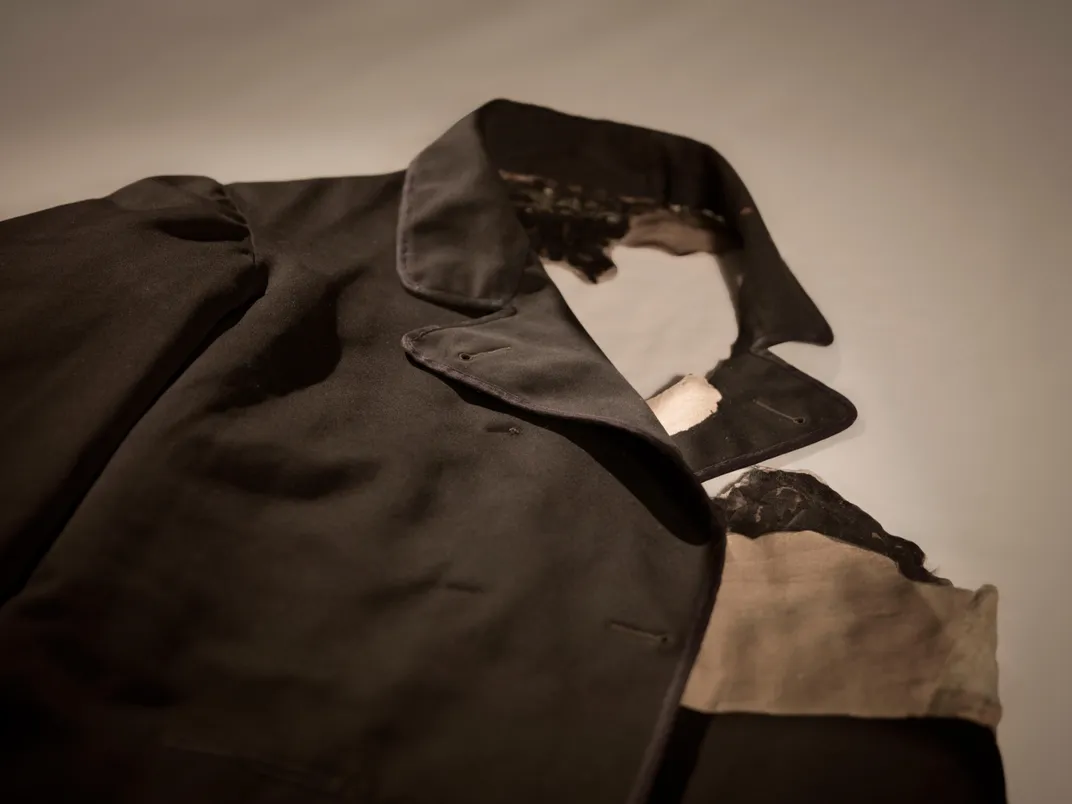
Lincoln’s Top Hat and Overcoat
Nothing from the president’s wardrobe more potently symbolizes his identity than his top hat. Lincoln adopted one as his trademark back in Illinois, when he was a lawyer, long before he came to Washington. He chose unusually tall hats to attract attention and accentuate his height. At 6-foot-4, Lincoln already towered over most of his contemporaries; his hat made him look like a seven-foot giant. This is the hat that he wore on April 14, and that he doffed when he stood in the President’s Box at Ford’s and bowed to acknowledge the jubilant audience of his fellow citizens.
Lincoln’s signature color was black, and throughout his presidency he wore a white shirt, black pants and a thigh-length frock coat. And the night he went to Ford’s Theatre, he wore a custom-made black wool Brooks Brothers overcoat trimmed at the collar, lapels and cuffs with grosgrain piping. The black silk quilted lining was stitched with the outline of a large American eagle, a shield of stars and stripes and the motto “One Country, One Destiny.” How eerily appropriate that when Lincoln was murdered, his body was draped in a garment writ large with the words for which he gave his life.
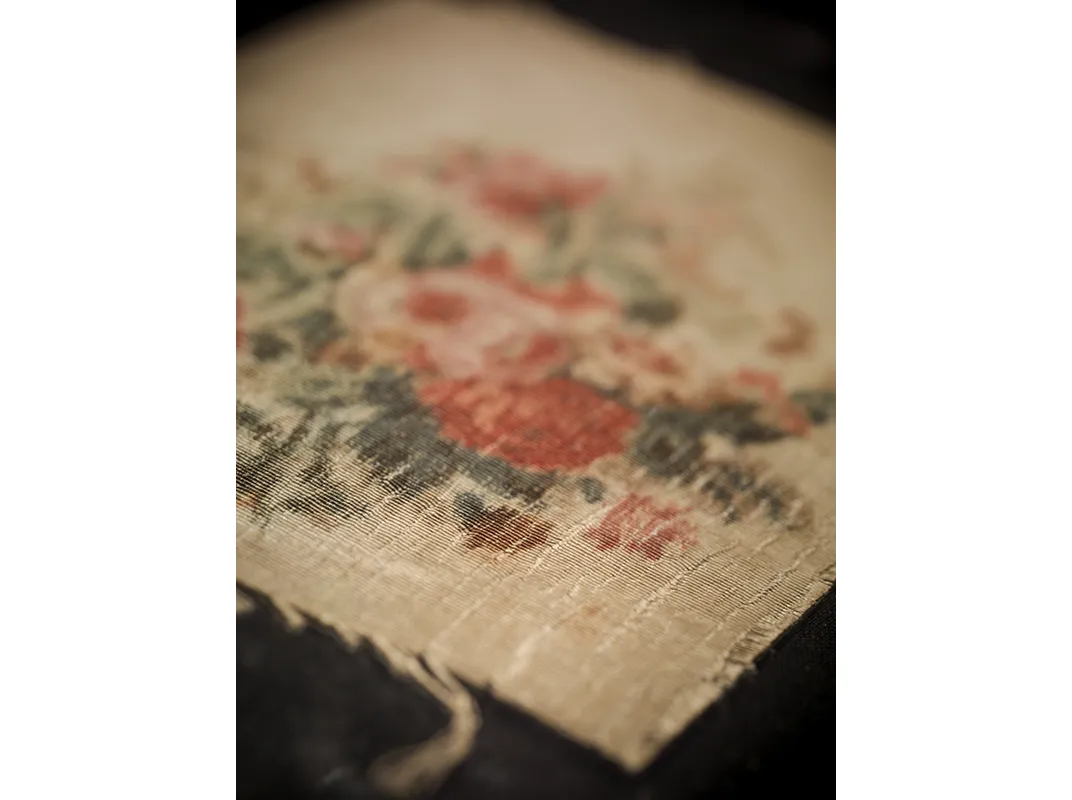
Swatch of Laura Keene’s Costume
After Booth fled Ford’s, Laura Keene raced from the stage to the President’s Box, where she discovered that Dr. Charles Leale had laid Lincoln on the floor. She knelt beside the unconscious, dying president and cradled his head in her lap. Blood and brain matter oozed from the bullet wound onto her silken costume, staining its festive red, yellow, green and blue floral pattern. Like a Victorian bride who lovingly preserved her wedding dress, Keene cherished her frock from this terrible night. But it soon became an object of morbid curiosity—strangers tried to cut swatches as gruesome keepsakes—and she eventually exiled the haunted relic into her family’s care. The dress vanished long ago, but miraculously five swatches survived. For more than a century, they have been legendary among collectors. The whereabouts of this example had been unknown until it surfaced in the late 1990s, and I acquired it. This one, according to an accompanying letter of provenance from Keene’s grandson, was presented to a longtime family friend. The gay floral pattern remains almost as bright as the day the dress was made more than 150 years ago in Chicago by dressmaker Jamie Bullock. But the red bloodstains faded long ago to a pale rust-brown.
When I was working on Manhunt, I never let this swatch out of my sight while I wrote the scene describing what happened in the President’s Box after the shooting. As I stared at this blood relic, I saw it all, and the paragraphs wrote themselves.
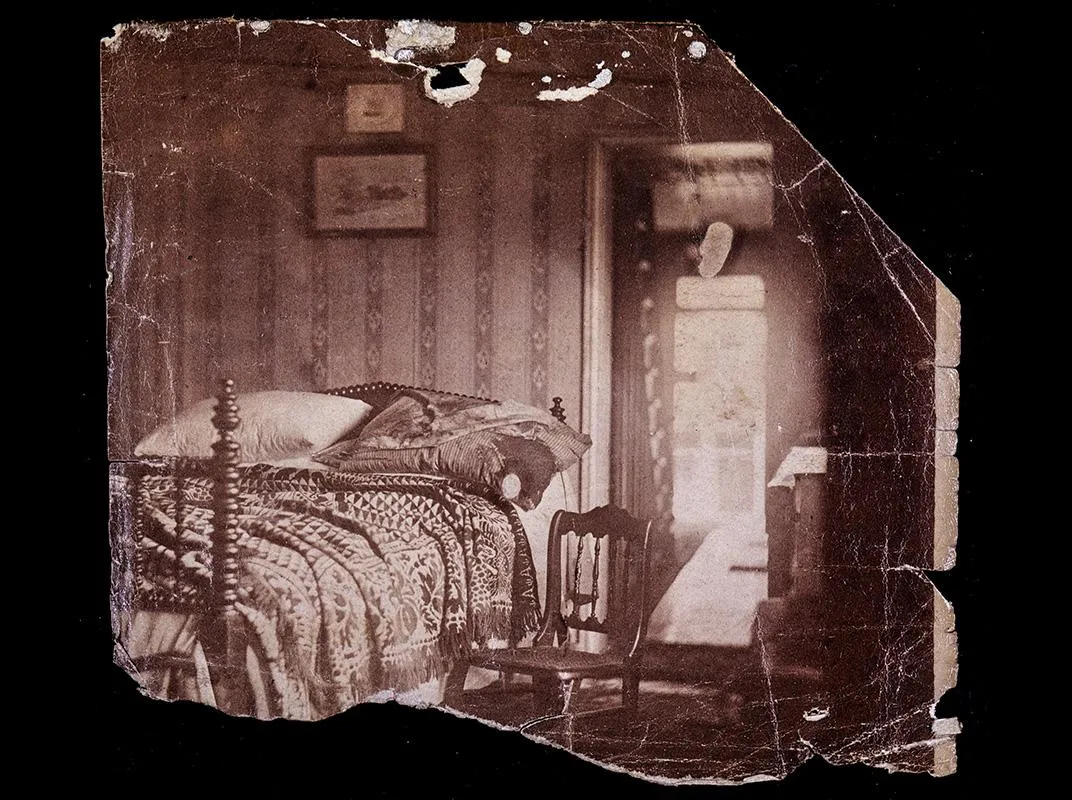
Lincoln’s Deathbed
At 7:22 and 10 seconds a.m. on April 15, after an all-night vigil, Abraham Lincoln died in a back room at the Petersen House on a bed that was too small for his frame. The doctors had had to lay him diagonally atop the mattress. Soldiers wrapped his naked body in an American flag and put him into a plain pine box—a rectangular military crate. Lincoln, the former rail-splitter, would not have minded so simple a coffin. After they took him home to the White House, sheets, pillows, towels and a coverlet lay on the boardinghouse bed, still wet with the president’s blood. Two Petersen House boarders, brothers Henry and Julius Ulke, one a photographer and the other an artist, set up a tripod camera and, with the morning sun flooding the hallway from the front door all the way back to the little rear room, photographed the scene.
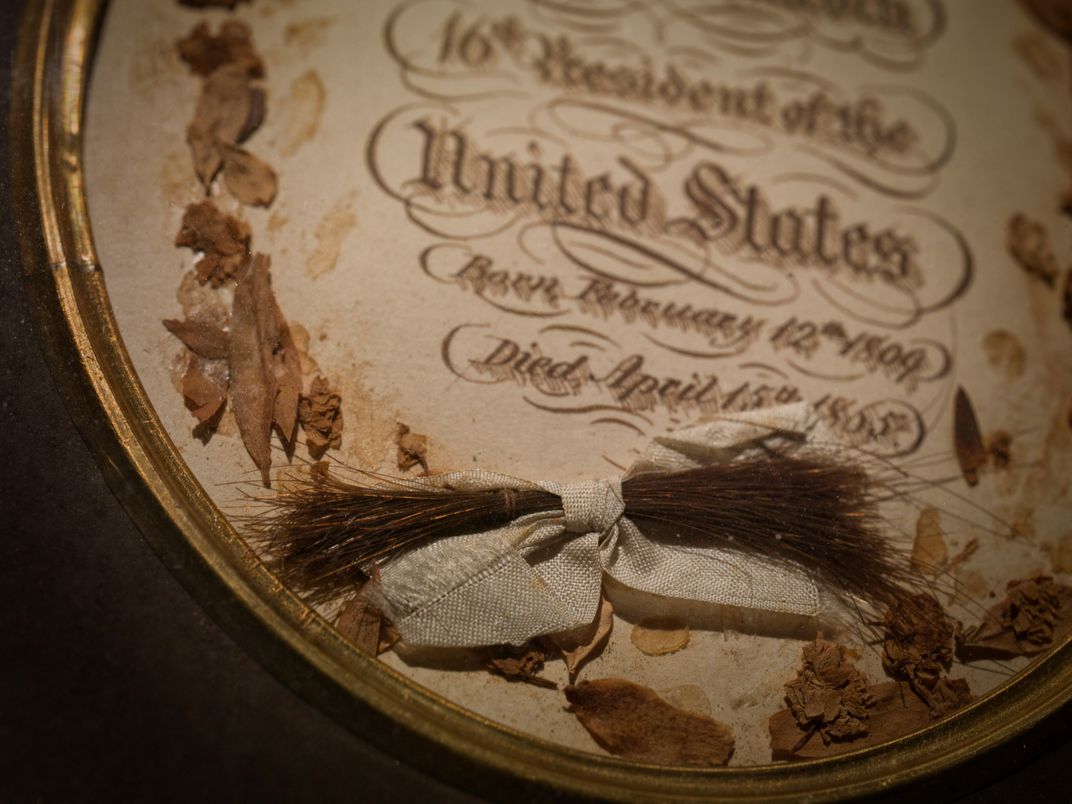
Lock of Lincoln’s Hair
Within an hour after the assassination, Mary Lincoln summoned Mary Jane Welles to the Petersen House. Mary Jane, the wife of Navy Secretary Gideon Welles, was one of Mary’s few friends in Washington. They had bonded over shared sadness: In 1862, Mary Jane had helped nurse 11-year-old Willie Lincoln until he died of typhoid fever; the next year, the Welleses lost their 3-year-old son to diphtheria. On the morning of April 15, Lincoln’s death room emptied of mourners (including Gideon Welles) save one: War Secretary Edwin M. Stanton, whom Lincoln called his “Mars, God of War.” Stanton was an imperious and widely feared cabinet secretary, but he had loved the president, and the assassination was for him a profound personal tragedy. Alone with his fallen chief, Stanton cut a generous lock of the president’s hair and sealed it in a plain white envelope. He knew who deserved the memento. After signing his name on the envelope, he addressed it “For Mrs. Welles.” When she received it later that day, she inscribed the envelope in pencil in her own small, neat hand: “Lock of Mr. Lincoln’s hair April 15, 1865, M.J.W.”
She mounted the lock in an oval gold frame, along with dried flowers she collected from Lincoln’s coffin at the April 19 White House funeral. The card securing the relics in place behind their glass cover was calligraphed to testify that they were “Sacred to the Memory of Abraham Lincoln 16th President of the United States.” This isn’t the only surviving lock of Lincoln’s hair. Mary Lincoln claimed one, as did several of the doctors present at the Petersen House or his autopsy. Others were purloined from Lincoln’s head, and one wonders how he made it to the grave with any hair at all. But the Stanton/Welles lock, with its unparalleled provenance and interwoven tales of love and loss, is perhaps the most evocative one of all.
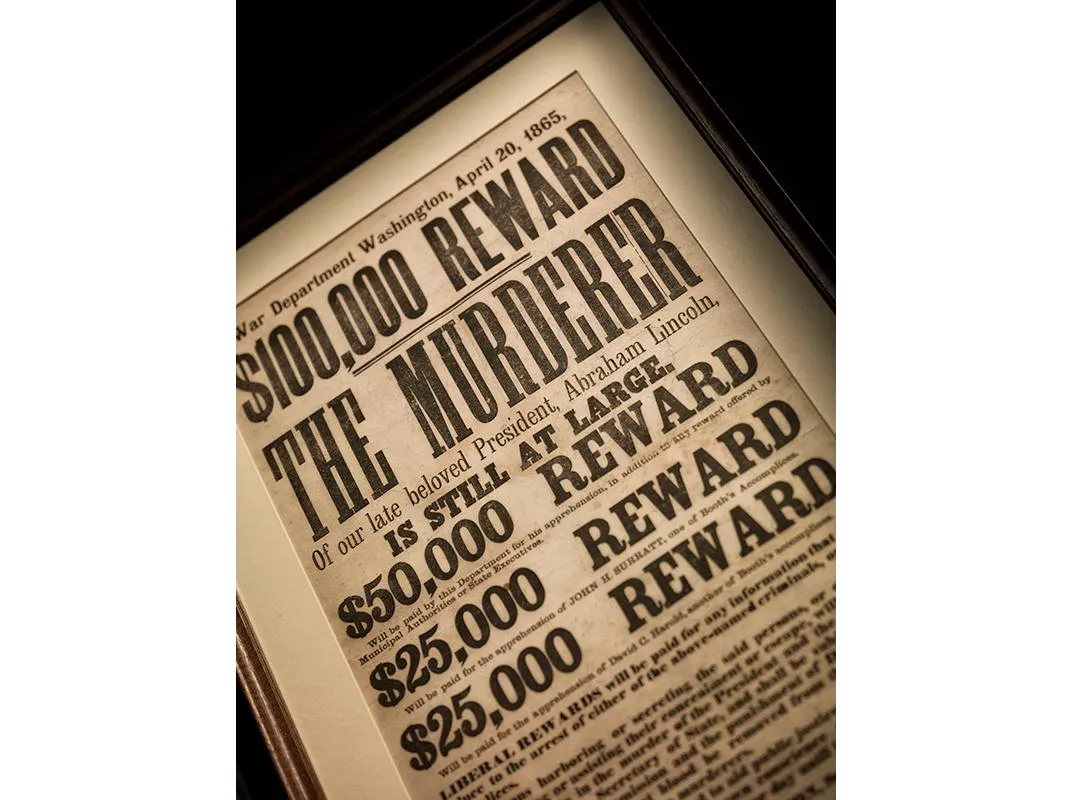
$100,000 Reward Poster
Today, it is the most famous reward poster in American history. In 1865, it was the symbol of a failing, increasingly desperate manhunt. And when I was 19 years old, it was my first important acquisition. I had coveted one of these posters since I was 10, and when I was a sophomore at the University of Chicago I spotted one in a book dealer’s catalog and ordered it at once. I bought the poster instead of a used car.
Booth shot Lincoln in front of 1,500 witnesses, escaped from Ford’s Theatre, galloped away on a horse and vanished to parts unknown. The failure of several thousand pursuers to hunt down Lincoln’s assassin had become an embarrassment to the government. On April 20, six days after the assassination, War Secretary Stanton proclaimed a $100,000 reward for the capture of Booth and two of his alleged accomplices. It was a staggering sum—the average worker was earning about $1 a day—and the War Department printed broadsides to publicize it. Every penny of the blood money was paid, divided among a few dozen of the pursuers most credited for the capture or death of John Wilkes Booth and his accomplices.
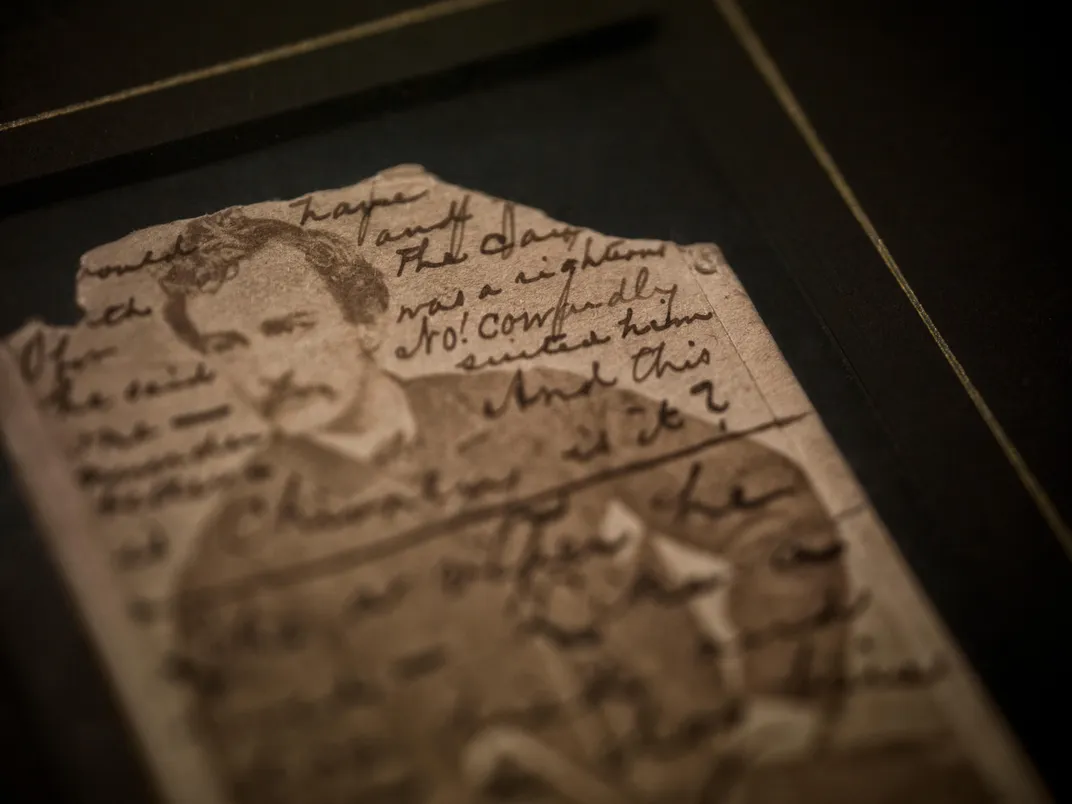
Defaced Photograph
The day after the assassination, technicians at the Surgeon General’s photo laboratory copied a popular carte-de-visite photo of Booth and printed multiple examples for distribution to the assassin’s pursuers. This copy was issued to William Bender Wilson, a telegraph operator at the War Department who was in the field during the manhunt. Wilson inscribed its provenance on the back of the card: “This picture of J. Wilkes Booth was given to me from the War Department at Washington, D.C. whilst Booth was still a fugitive. Wm. B. Wilson.” Upon learning of Booth’s death, Wilson expressed his contempt for the murderer by defacing his image with a handwritten message: “...for the cause he said was a righteous one. No! Cowardly murder suited him better. And this is Chivalry is it? Like a viper he lived—like a dog died, and like a dog buried. ‘Assassin.’ ‘Booth the accursed.’” Few other relics preserve so well the passions unleashed in April 1865.
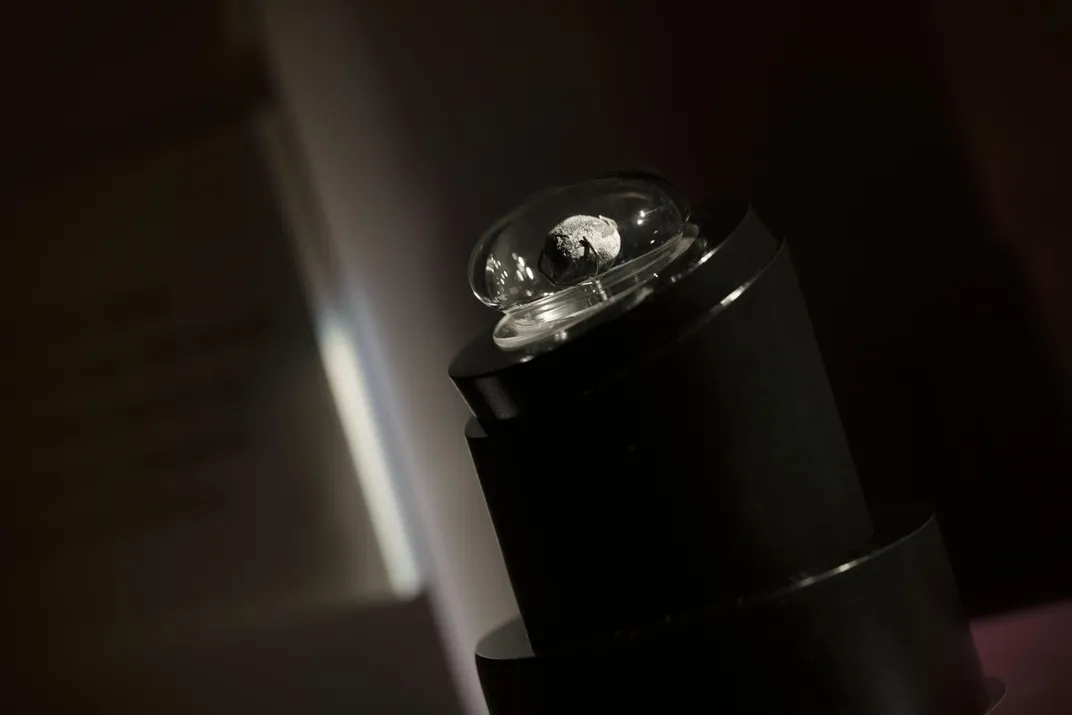
The Bullet That Killed Lincoln
Booth fired a lead ball at Lincoln’s head. The bullet entered below the president’s left ear, bored diagonally through his brain and stopped behind his right eye. Lincoln never regained consciousness. No autopsy was necessary to determine the cause of death, but it would have been obscene to bury the president of the United States with a bullet in his brain. It had to be dug out. Edward Curtis, an assistant surgeon at the autopsy, described the hideous work: “I proceeded to open the head and remove the brain down to the track of the ball. Not finding it readily, we proceeded to remove the entire brain, when, as I was lifting the latter from the cavity of the skull, suddenly the bullet dropped out through my fingers and fell, breaking the solemn silence of the room with its clatter, into an empty basin that was standing beneath. There it lay upon the white china, a little black mass no bigger than the end of my finger—dull, motionless and harmless, yet the cause of such mighty changes in the world’s history as we may perhaps never realize.” Whenever I visit this bullet at the National Museum of Health and Medicine in Silver Spring, Maryland, I hear its echo in the basin.
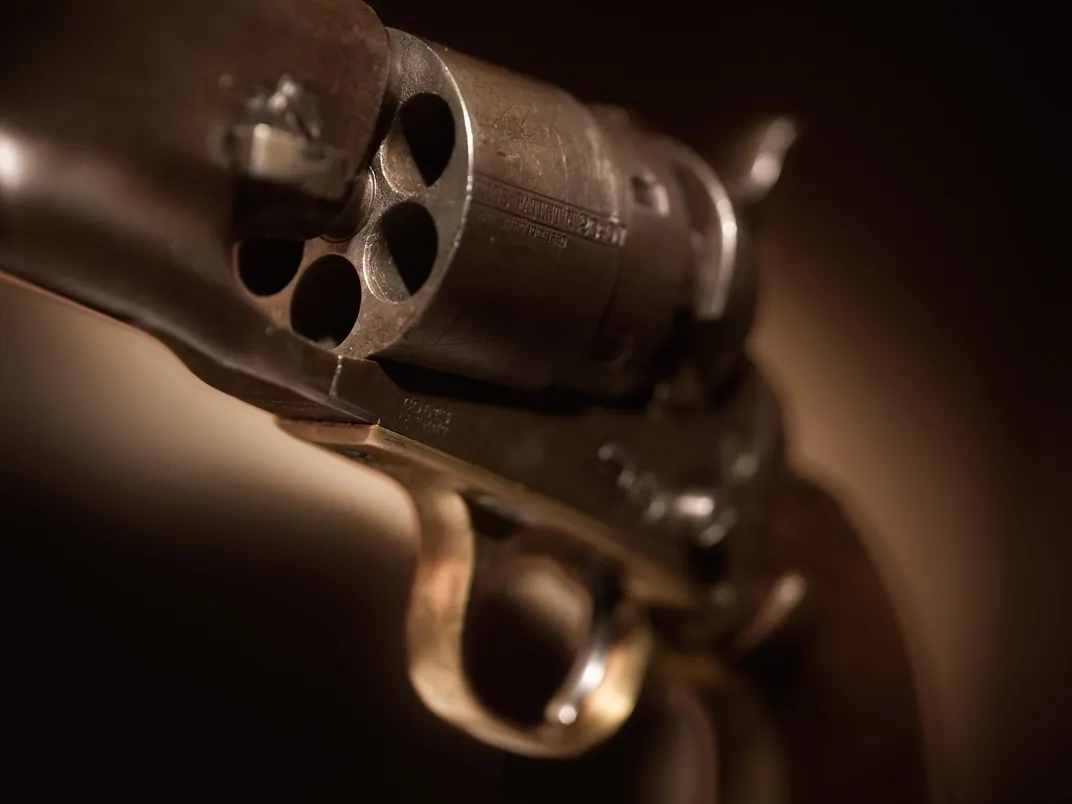
Booth’s Arsenal
Booth’s Deringer is just one of several arms he purchased for his March 1865 plot to kidnap the president and soon deployed in his plot to kill Lincoln. Booth had two Colt revolvers and a Spencer repeating carbine with him when he was killed. He had issued a revolver and knife to George Atzerodt, who was supposed to murder Vice President Andrew Johnson. (Atzerodt got drunk and ran away, throwing the blade into the street and selling the pistol at a Georgetown shop.) Booth lent a knife and Whitney revolver to Lewis Powell, who made a bloody but failed attempt to kill Secretary of State William Seward. (Powell broke the pistol on the skull of one of Seward’s sons and used the knife to stab Seward nearly to death, along with several other members of his household.) Along with his Deringer, Booth carried into Ford’s Theatre a Rio Grande camp knife, which he used to stab Lincoln’s guest Maj. Henry Rathbone in the theater box, and which, after he leapt to the stage, he thrust above his head for all the audience to see as he shouted, “Sic semper tyrannis” (“Thus always to tyrants”). The audience was too far away to read the mottoes acid-etched onto the blood-smeared blade: “Land of the Free/Home of the Brave”; “Liberty/Independence.” How strange that the president and his assassin both embraced those sentiments.
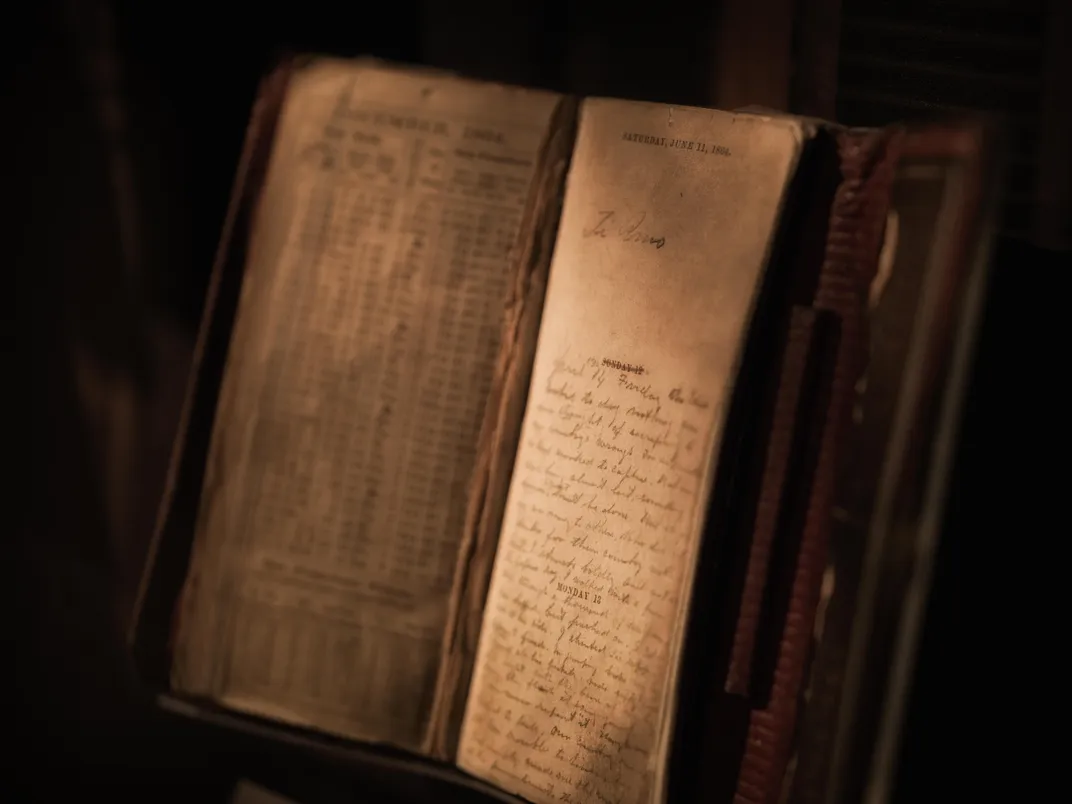
Booth’s “Diary”
Contrary to popular belief, Booth never kept a “diary” of the Lincoln assassination. During the manhunt he carried a small bound pocket calendar for the year 1864, which contained several blank pages, and on those sheets he wrote several notorious entries. To read them today is to encounter the mind of the assassin in all its passion, vanity and delusion: “Our country owed all her troubles to him, and God simply made me the instrument of his punishment”; “After being hunted like a dog through swamps, woods and last night being chased by gun boats till I was forced to return wet cold and starving, with every mans hand against me, I am here in despair”; “I am abandoned, with the curse of Cain upon me”; “I bless the entire world. Have never hated or wronged anyone. This last was not a wrong, unless God deems it so.” The notebook takes readers back to Booth’s hiding places. It is easy to hear his pencil scratching against paper as he scribbles his final thoughts. One can imagine the soldiers plundering it from his body and rifling through its pages in the firelight of the blazing tobacco barn, or War Secretary Stanton scrutinizing it for clues about the assassination after it was brought back to Washington.
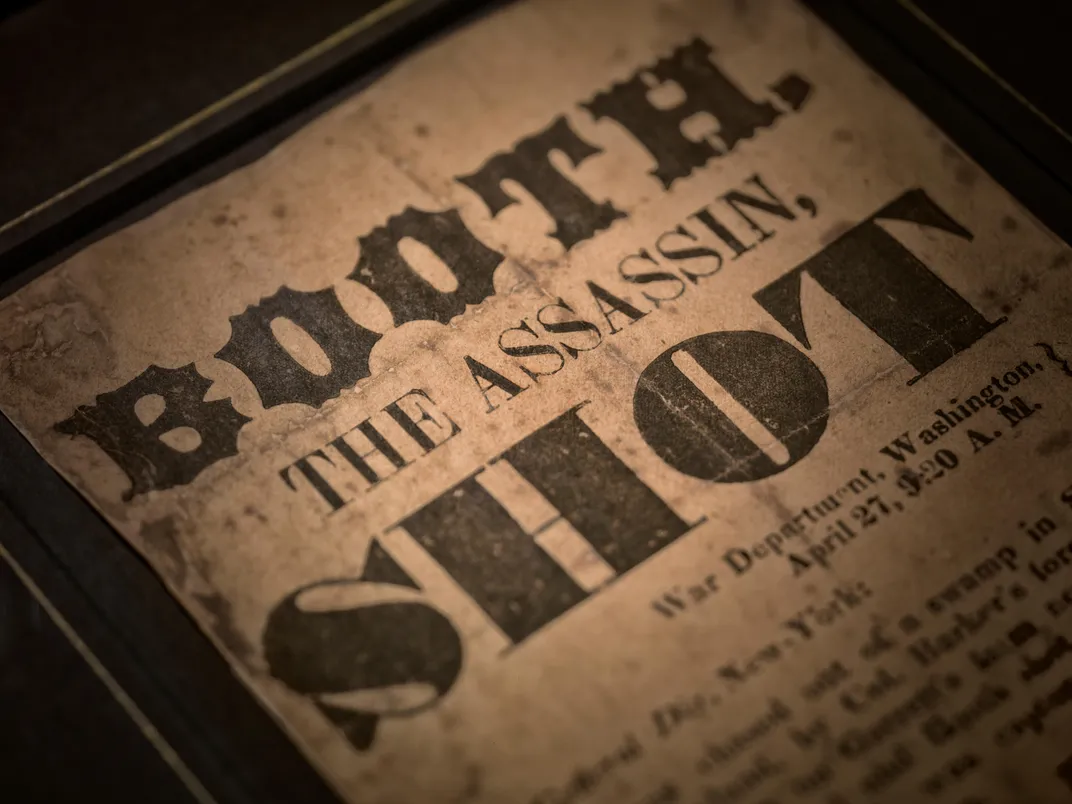
Broadside Announcing Booth’s Death
After Booth died, at sunrise on April 26, Col. Everton Conger, one of the leaders of the patrol that had tracked him down, rushed back to Washington to report to his superior, detective Lafayette Baker. Together, at about 5:30 p.m., they went to Edwin Stanton’s home to give him the news. “We have got Booth,” Baker told him. The exhausted war secretary had no energy for grand language or historical pronouncements. The statement he drafted, and which a War Department telegrapher transmitted across the nation, contained just the news that America had been waiting 12 days to hear. A broadside repeated the report:
BOOTH, THE ASSASSIN, SHOT
War Department, Washington. April 27, 9:20 A.M.
Maj. General Dix, New-York:
Booth was chased out of a swamp in St. Mary’s county, Maryland,
by Col. Barker’s [i.e., Baker] force, and took refuge in a barn on Garrett’s farm, near Port Royal. The barn was fired and Booth shot and killed. His companion, Harrold [David Herold], was captured. Harrold and Booth’s body are now here.
E.M. Stanton, Secretary of War.
When a unique example of this broadside, hitherto unknown, surfaced unheralded a decade ago at a small regional auction, I added it to my archives. It is published here for the first time.
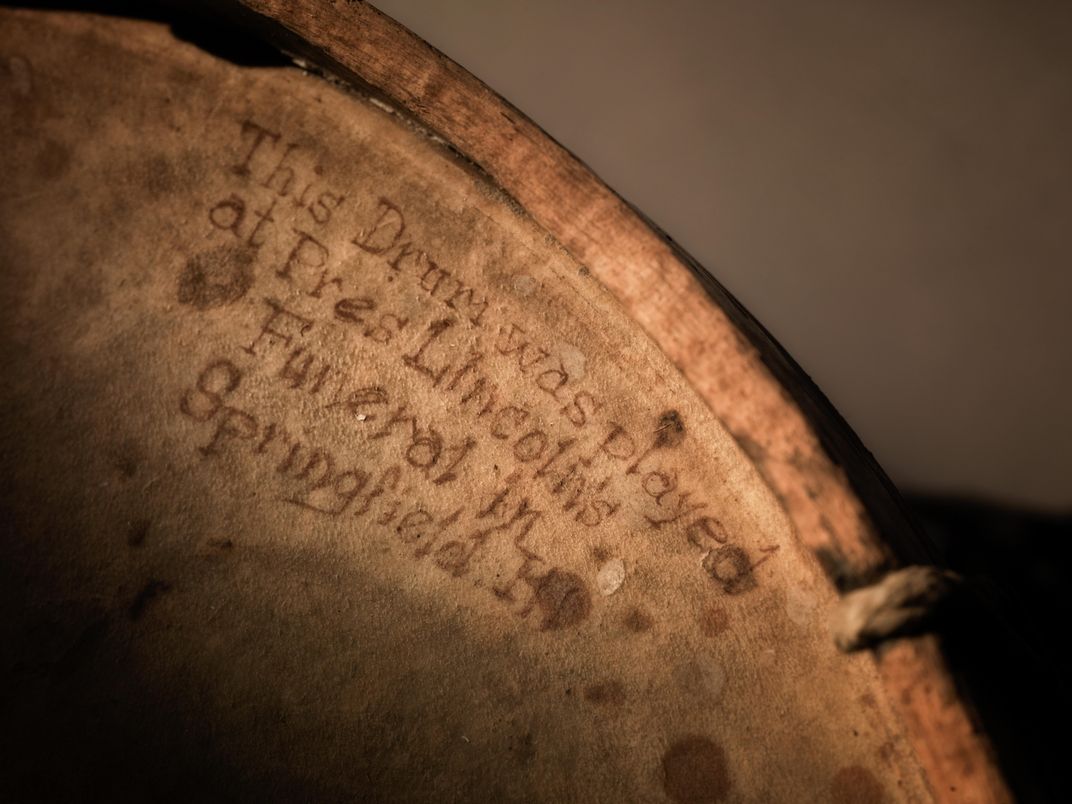
Mourning Drum
Abraham Lincoln’s final journey began when soldiers placed his corpse aboard a special train that traveled the 1,600 miles from Washington, D.C., to Springfield, Illinois, over 13 days. One million Americans viewed his corpse in the great cities of the North, and seven million people watched his funeral train pass by. Whenever Lincoln’s body was removed from the train for a public viewing, military units joined the procession, and the troops marched to the sound of massed drums. In Springfield, the corpse was displayed for 24 hours in an open casket at the State House, where Lincoln had served as a legislator and given his famous 1858 “House Divided” speech. And at 11:30 a.m. on May 4, 1865, the drums beat one last time for Father Abraham as the funeral procession exited the State House and passed Lincoln’s old home at Eighth and Jackson streets en route to Oak Ridge Cemetery.
One of those drums—a long-lost relic bearing a patina of dust and neglect—was recently discovered in Illinois. It is no different from thousands of military company drums manufactured during the Civil War for use by teenage drummer boys in an infantry company of one hundred men. It has a body of unpainted tulipwood or ash, calfskin heads, painted oak rims, hemp cords and leather pulls to adjust the tautness of the heads and the brightness of the sound. This one was made in Granville, Massachusetts, by Noble & Cooley, a firm founded in 1854 and still in business today. Its oak rims have been beaten down from countless drumstick strikes—more than on any other Civil War drum I’ve ever seen—and no marks indicate which regiment or company the drummer played for. But a remnant of black mourning ribbon—a few inches from a coil that must have once laced the drum—still hangs from the bottom rim. And on the top head, written in ink, is a remarkable history: “This Drum was Played at Pres Lincoln’s Funeral in Springfield Ill.” On the day I acquired it, I held a pair of Civil War-era drumsticks in my hands and—careful not to damage the fragile calfskin head—tapped out faintly the muffled sound of the funeral march.
Editor's note: This story initially said that Booth fired a one-ounce lead ball at Lincoln's head. While the plaque beneath Booth’s Deringer at the Ford’s Theatre Museum lists the weight of the bullet as “nearly an ounce,” the National Museum of Health and Medicine, where the bullet is displayed today, says it has no record of its weight and it cannot be weighed now because it has been permanently mounted. Bullets in the 1860s were not uniform. A firearms expert at the National Museum of American History says 0.32 ounces is well within the realm of reason.
Related Reads
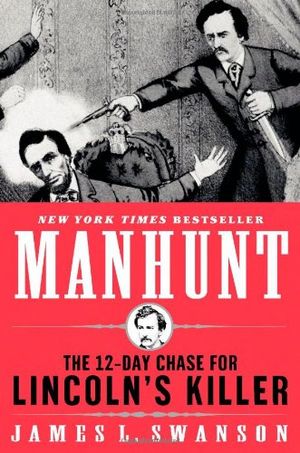
Manhunt: The 12-Day Chase for Lincoln's Killer